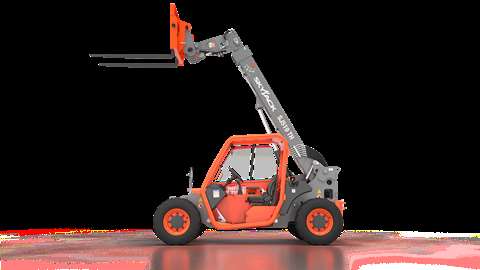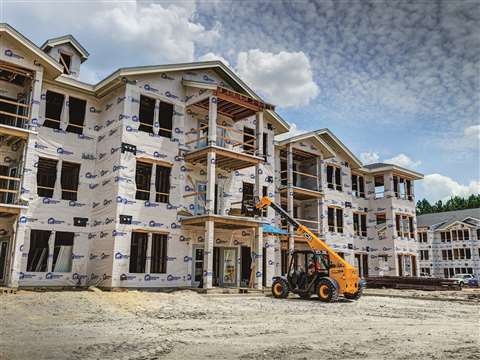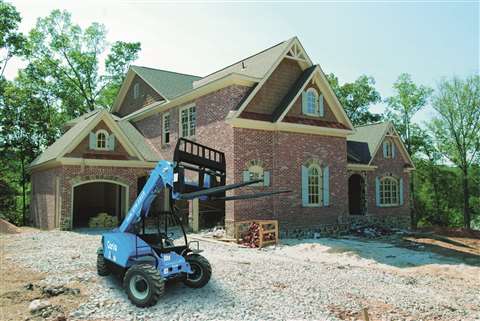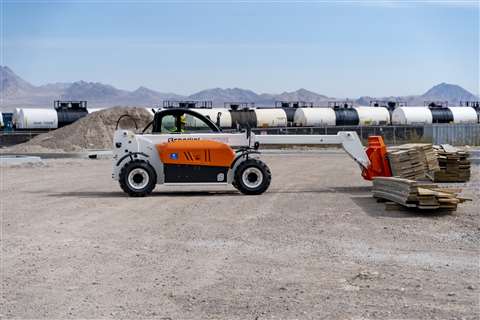Micro machines matter
28 June 2021
Despite their small stature, compact telehandlers can tackle a range of jobs, from moving construction materials to finalizing landscape. ALH covers the latest.
Like their larger-sized counterparts, super compact telehandlers – units with less than 5,500-pounds of lift capacity – are typically the first machines on the jobsite and the last to leave. The applications for these compact machines vary greatly from the initial phases of a large construction project, where the machines can be found unloading trucks and delivering materials, to the closing stages where they can be utilized for jobsite clean-up and landscaping.
The biggest market and applications for compact telehandlers continues to be general construction. Other markets/applications include agriculture, landscaping and hardscaping, parking garage construction and maintenance, refurbishment construction as well as residential construction.
John Boehme, JLG’s senior product manager, explained: “[The] ultra-compact class is one of the fastest growing telehandler classes. Like with the more traditional compact telehandler size class, we believe the ultra-compact (sub 3K lifting capacity) provides another equipment solution to meet contractors’ jobsite needs.
“These smaller telehandlers offer low machine height and weight, which means that they are a good equipment option to consider for work in extremely space-restricted jobsites.”
An advantage of compact telehandlers in suburban and urban applications compared to larger models, or other types of equipment, is that they have a small footprint yet still offer plenty of power. For example, trucks still need to be loaded/unloaded on sites in space-restricted downtown areas, and when contractors need to move jobsite materials from place to place they have to have equipment that fits on the road and can maneuver around various obstacles.
 Skyjack’s SJ519 TH is the company’s most compact telehandler.
Skyjack’s SJ519 TH is the company’s most compact telehandler.
Boehme added: “With less and less open space, new buildings are becoming taller and placed closer together. This is driving higher demand for smaller footprint telehandlers, like the new super compact JLG Skytrak 3013 model.”
The JLG SkyTrak 3013 ultra-compact telehandler was purpose-built for use in small spaces requiring up-and-over reach such as agriculture, hardscape, landscape and light construction work. The 3,000-pound class telehandler is well-suited for loading and unloading pallets from flatbed trucks, as well as lifting and placing materials at heights up to 13 feet.
This 3013 telehandler weighs 5,300 pounds with a load capacity of 2,700 pounds. The SkyTrak 3013 is available with a variety of options that includes open and fully enclosed cabs, a cold weather package, work lights, universal skid steer coupler and a variety of tires.
Boehme declared: “With a similar size and footprint compared to a skid steer, but with the additional capabilities that only a telehandler can offer — additional lift height and forward reach, as well as exceptional terrainability — compact telehandlers offer contractors more options to choose from to get work done.
“For example, the ultra-compact JLG Skytrak 3013 telehandler can be used in place of a skid steer to give you more reach, greater lift height, increased up-and-over reach and enhanced terrainability. But it also fits on a standard trailer, so it can easily be transported between landscaping and hardscape jobs.”
Curb appeal
Rebecca Yates, JCB’s product manager – material handling, enthused: “The compact market segment continues to grow and most of that growth comes from users who need more reach, which leads them to opt for a compact telehandler instead of a skid steer.
“What’s great about this growth for JCB is that it’s led to an increased demand of the JCB Teleskid. The Teleskid is the industry’s only skid steer with a telescopic boom offering operators the ability to lift higher, reach further and dig deeper than a traditional skid steer.”
With a telehandler’s additional reach compared to a skid steer, both in lift height and forward, paired with faster travel times then there are definitely certain applications where a compact telehandler would be chosen over a skid steer – but skid steers still have their place.
Yates added: “Where a skid steer may be more beneficial is in applications, where the ground conditions warrant tracks. Or if the operator requires the ability to run higher auxiliary flow attachments and/or include electric connections.
“Operators should also consider their requirements for cab size and overall visibility to decide between a compact telehandler and a skid steer.”
JCB states that there has been increased demand for sub-compact telehandlers.
Yates affirmed: “What’s important to keep in mind with the sub-compact size is that with the decrease in capacity, where an operator would see the largest benefit, is in the combination of reduced overall height – allowing access to smaller sites such as a parking garage or a poultry barn and lighter overall weight, providing the ability to tow the machine on a small trailer without the requirement for a special license.
“With this combination of reduced overall height and lighter machine weight, a sub-compact becomes an easier to access option for smaller rental companies and weekend household jobs.”
JCB introduced the 505-20E electric compact telehandler at the end of 2020. The 505-20E is a fully electric version of the popular 505-20 JCB telehandler.
 JCB manufactures a range of compact telehandlers, including the 505-20TC.
JCB manufactures a range of compact telehandlers, including the 505-20TC.
Designed to deliver the same performance as the conventional diesel-powered machine, the 505-20E offers a zero-emissions material handling solution to construction, industrial and agricultural customers. The 505-20E is expected to be available in North America in mid-2021.
Yates explained: “The compact telehandler market has continued to stay consistent and strong and I see that as likely to continue. The compact market segment’s appeal is its ability to be used in all types of applications and environments, the little machine on a big jobsite or the primary machine on a small one.
“It’s also capable of being used in all industries, construction, agriculture, industrial and even the military. JCB has a telehandler to meet the needs of all of these sectors with a number of compact models, including 504-13TC, 505-20TC, 525-60AgriPlus and the Light Capability Rough Terrain Forklift.”
Machine enhancements
Genie contends that the compact telehandler market is seeing strong signs of recovery compared to last year, and that rental demand started higher at the start of 2021.
Genie’s GTH-5519 is the company’s smallest telehandler product, and despite it having been introduced to the market by Terex back in 2000, it has undergone a number of updates over the past two decades.
 Genie’s littlest lifter is the GTH-5519.
Genie’s littlest lifter is the GTH-5519.
Josh Taylor, product manager of telehandlers for Genie, said: “Everyone is optimistic about a stronger market this year. We have improved the performance of the HVAC system, added a dedicated lifting shackle and made efficiency improvements to the hydraulic and cooling systems.
“Genie has a culture of continuous improvement, and these design changes presented opportunities to pass even more value to the customer.”
Caterpillar’s Telehandler product application specialist Mike Peterson acknowledged that at their core, super compact telehandlers are still primarily a rough-terrain telescopic forklift.
Peterson enthused: “Dimensionally confined to less than 72-inches-wide, [super compact telehandler’s] size, along with the telescopic boom, allows access to many tight situations that are normally off limits to compact wheel loaders, skid steer loaders and compact track loaders.
“From agriculture, with applications in poultry or smaller livestock applications, to landscaping and even larger commercial applications, there are very few markets and applications that do not utilize super compact telehandlers.”
The Cat TH255C features a 5,500-pound load capacity and maximum lift height of 18.37 feet. The unit offers a variety of bucket options, from general purpose to larger capacity light material buckets, Grapple buckets and multi-purpose 3-in-1 buckets. Within the agricultural market segment, attachments such as bale grabs, bale spears and muck grapples are options.
Peterson added: “Often configured with a universal skid steer coupler installed, either as standard equipment or as an optional selection, super compact telehandlers do share some common traits with skid steer loaders and compact track loaders.
“While this potentially allows for significant attachment versatility, the overall opportunity is constrained by OSHA regulations requiring each potential attachment to be approved by the manufacturer and have a corresponding load capacity chart indicating nominal lift capabilities.
“Care does need to be taken in evaluating the potential for Skid Steel loader attachments, since it is not a loader. Due to its telescopic boom design, it is more sensitive to corner loading impacts.”
Environmentally conscious
Technology is continuously developing, and globally the focus on reducing emissions produced by off-highway construction equipment, including telehandlers, continues to expand exponentially.
Boehme explained that there are two drivers for this growth, namely existing and future legislation on emissions and noise as well as the desire to drive down equipment’s total cost of ownership (TCO).
He said: “Responding to these, the aerial market has changed in the last few years. In the past, telehandlers were powered by the biggest, most powerful internal combustion (IC) engines that an individual equipment model could support. But today, that’s all changed.
“The new trend is toward owning and operating equipment that comes equipped with the latest hybrid technology, direct drive and/or lithium-ion batteries.”
Currently, electrical technology does tend to lend itself to be more applicable for smaller machines, and there are several electric-drive telehandler models already available in the market.
Snorkel introduced the world’s first lithium electric compact rough terrain telehandler, the SR5719E, into North America in 2020. The company is pleased that it is starting to see other models enter the electric telehandler sector.
 Snorkel introduced the fully electric, compact SR5719E in 2020.
Snorkel introduced the fully electric, compact SR5719E in 2020.
Matthew Elvin, CEO of Snorkel and Xtreme Manufacturing, stated: “We predict that this will be a developing trend in the coming years, as highly populated cities and urban areas implement increasing dust, noise and emissions regulations.
“As always, the 10,000-pound and 12,000-pound classes will be very popular, thanks to their widespread versatility around most construction jobsites. However, we expect to see increasing adoption of the electric, compact, rough terrain telehandlers, thanks to their flexibility to be used indoors and outdoors, and the running cost savings over the diesel equivalent.”
Manufacturers also note that as prices for these technologies go down, the market will have more acceptance of pure, electrically powered telehandlers.
“We anticipate that as lithium-ion batteries become more affordable, that the technology will become more accessible. Therefore, there will be less need and demand for hybrid models in the future. This will be because the performance of a lithium-ion operated machine is equal to a conventional diesel-powered machine.”
JLG said that because of these trends, customers are asking for more electrified equipment solutions, and telehandler OEMs are working to provide innovative, productive solutions.
Boehme enthused: “We believe that electrification options in this equipment category will continue to evolve.”
For Skyjack, which manufactures the 5,500-pound-lifting-capacity SJ519 TH, demand for electric/hybrid telehandlers is currently regional specific.
Kurt Atchison, senior product manager for Skyjack, claimed: “In the European market, you see the number of manufacturers developing these types of machines continuing to grow to support changing emission standards and requirements.
“In North America there is very little demand for large electric/hybrid telehandlers and, while demand for compact telehandlers is still fairly minimal, it is starting to be discussed.
”Their compact size and the variety of applications they can support often means that a compact telehandler can be one of the first machines on a job site, and the last off. Being able to operate with reduced emissions and noise makes it well suited for the last few stages of construction.”
IoT is also changing how equipment is developed – and how it interacts with other equipment, operators and technicians.
Boehme said: “For operators and owners, equipment is becoming more connected, allowing it to provide valuable data throughout the workday for decision making and planning purposes. For rental companies, this connectivity can help improve fleet utilization, maintenance, serviceability and uptime.”
Although not specific to telehandlers, digital solutions are also expanding for use during the initial design and planning stages, through finish work. These solutions are making jobsites more efficient and include BIM modeling and augmented reality apps. Both help rental companies and contractors plan for and select the right equipment for the work at hand.
With technology advancements affecting every aspect of equipment design and use, the future is bright – and connected – for this industry’s tiny workhorse.

